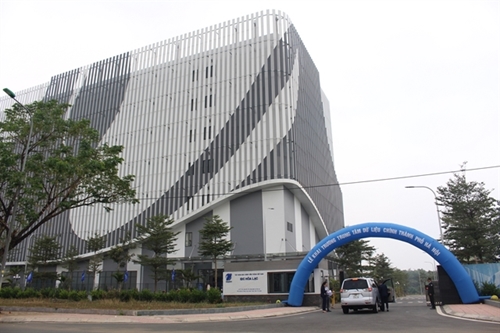Yet, by international standards, the capacity of Vietnamese businesses and organizations to respond to these incidents remains limited. A report by US-based digital communications technology conglomerate Cisco revealed that only 11% of Vietnamese businesses and organizations have reached a level of readiness to effectively handle cybersecurity breaches.
    |
 |
|
The Vietnam Posts and Telecommunications Group (VNPT)’s Internet Data Center (IDC) in Hoa Lac Hi-Tech Park in Hanoi. |
No absolutely safe systems
In April, the local CMC Technology Group fell victim to a ransomware attack, which disrupted services for more than 10 hours. According to a spokesperson of the company, the attack targeted a small-scaled subsidiary that provided a specialized service to a limited customer base.
Do Van Thinh, director of the cybersecurity monitoring center at CMC Cyber Security, shared that the group swiftly activated its cybersecurity response protocols, isolating the source of the attack and conducting a thorough review of its information security processes. Within 24 hours, the entire system was back under control, with services of the core subsidiaries unaffected.
Thinh stressed the importance of having sufficient incident-response materials and models, as well as clear response processes and responsibilities, to ensure effective response. Raising cybersecurity awareness across the organization, he noted, is also crucial.
Vu Ngoc Son, head of research, consulting, and technology development and international cooperation at the NCA, pointed out that most Vietnamese businesses still lack the capabilities, processes, or preparations necessary for countering cybersecurity threats.
A December 2024 survey by the association found significant security gaps across businesses: 14% lacked antivirus software, over 24% had no firewalls, and nearly 36% had no data backup or recovery solutions. Only 48% had cybersecurity monitoring in place. On the process side, just 53% had implemented a standardized procedure, and 64.12% proactively assessed their security situation. Particularly, around 20% of businesses and organizations had no dedicated cybersecurity staff.
During the first national-level live cybersecurity drill in April, over 40 vulnerabilities were discovered, highlighting the persistent risks and reinforcing the message that no systems are completely secure.
At a roundtable discussion held by the NCA on May 21, cybersecurity experts noted multiple factors behind the low preparedness of Vietnamese businesses and organizations, including their inadequate and inconsistent security measures, along with the slow adaptability to constantly updated technology and digital transformation, including the AI boom. Organized cybercrime gangs, particularly sophisticated and cross-border ones, have been mushrooming. Meanwhile, even some large Vietnamese enterprises with cybersecurity operations centers suffer from a shortage of skilled personnel to manage these systems. Compounding the problem, many staff members as well as leaders remain indifferent to cybersecurity, while regulations and security technologies lag behind evolving threats.
Comprehensive investment, concrete measures
Experts stressed that cyberattacks are not only aimed at stealing data or disrupting services but also target key government agencies and big enterprises, threatening national security and social order. The escalation of both the number and sophistication of those attacks demands immediate action to improve cybersecurity readiness.
Cybersecurity is not an optional add-on, Son said. It is a strategic responsibility that must be incorporated early into the core of every business’s risk management plan – from the very top down. He also urged leaders to actively participate in strengthening their companies and organizations’ cyber incident response capabilities.
Human remains the decisive factor, the expert added. Regular skill training and awareness improvement for all employees are essential, laying the foundation for effective technological and procedural measures.
In early May, Son went on, the NCA launched the first free cybersecurity course on its nCademy platform, equipping individuals with basic information security knowledge. Ongoing free courses, to be updated routinely, will be available on the platform to ensure users stay alert to new cybercrime tactics.
On the technological side, businesses and organizations need to invest in comprehensive and integrated security solutions that incorporate AI-powered data analysis and connect with global threat intelligence feeds for early detection and response to latent risks.
Equally important are clear incident-response procedures, well-defined roles and responsibilities, and up-to-date emergency contact lists for reporting and addressing incidents swiftly.
Around-the-clock security monitoring, standardized contingency plans and incident response procedures, as well as in-depth training courses and regular technical drills are vital to ensuring staff can respond promptly and effectively.
The National Cybersecurity Incident Response Alliance, established by the National Cybersecurity Center, gathers government agencies, technology firms, financial institutions, and critical infrastructure providers, aiming to provide information, early warning, and technical support in times of incident.
In a move to strengthen Vietnam’s legal framework, the Ministry of Public Security is proposing to merge the law on cyber information security and the law on cybersecurity into a single cybersecurity law in 2025, which is expected to be submitted to the National Assembly during its 10th session later this year.
Source: VNA